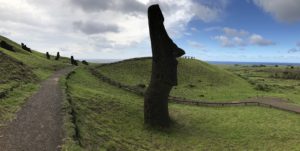We’ve covered a lot of ground with our Adventures In Stone, but this blog post is by far the most adventurous (and the most remote). This week I’m helping uncover the mysteries of Easter Island, although the locals prefer that we call their home Rapa Nui.
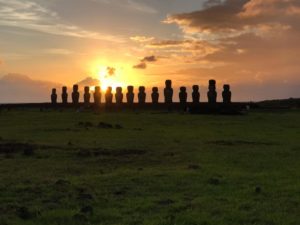
I am definitely not an expert of Rapa Nui, but I wanted to relate to you the stories of the island as spoken by the locals. This volcanic island not only has a mystique to it, but also a passion. The native Rapa Nui people are proud of their heritage and want to relate the story of their ancestors to visitors like me.
Let’s get to the good part now: the Moai statues! Moai are the monolithic human figures on Easter Island/Rapa Nui quarried and carved by the native people around 1250 to 1500 AD. These statues represented the former great leaders of the clans. These leaders, carved in stone, became the guardians of the various clans and are considered sacred.
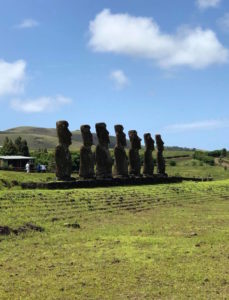
In life, the leaders of the clan painted their bodies yellow and grew their hair very long. They painted their long, uncut hair red and tied their locks on the top of their head into a top knot. With yellow bodies and red hair, these leaders resembled a proud rooster. When it came time to honor these leaders after death, the Rapa Nui wanted to choose stone that imitated this distinctive look. They chose the Tuff Rock because of its yellow tint and used it to carve the body of the statue. Red Scoria was quarried and became the top knot. The stones were carved by Obsidian spears, Basalt and Toki stone tools.

So you are probably wondering how the Rapa Nui people transported the Moai statues and top knots from the quarry to the Ahu (the porous basalt platform that the statues stand upon). There are many theories, but here’s what the natives believe: The Tuff Rock Moai statues, once carved in the quarry were “walked” by the people, rocking the statue from side to side until it reached its destination. This process required extreme strength and patience. The Red Scoria top knot hats are circular in shape and were somewhat easily rolled.
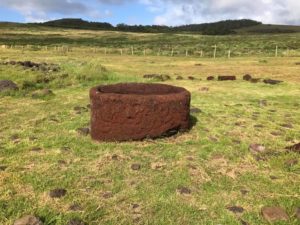
The Moai statues were placed on the Ahu platform and the top knots were placed on the head of the statue by leaning the Moai statue forward at an angle. Once the Moai was finally in place, coral eyes were placed on him and the Moai could now “see” and was awakened – the spirit of the leader could now protect his people.
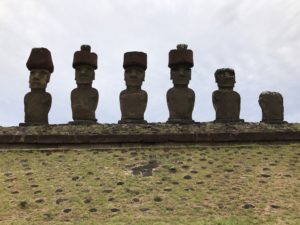
You may be wondering why you’ve seen some photos of the Moai statues on the Ahu platforms, while other statues are seen sticking out of the ground. A trip to the Tuff Rock quarry revealed all.
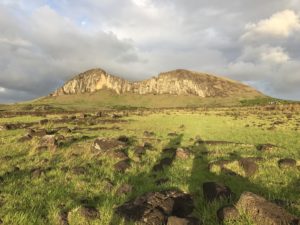
As you walk through the quarry there are many Moai heads scattered around the mountain; these were the statues that fell or toppled over during transportation and could not be used as a sacred Moai statue – pretty much the rejects that never made it to the Ahu.
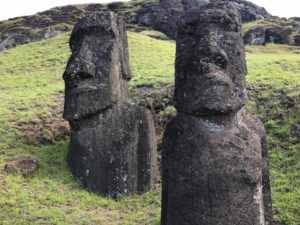
Ok, on to my favorite topic: Stone Restoration!
After a difficult period of time and illness, many of the Rapa Nui people became angry with the Moai statues – the spirits of the leaders were supposed to protect the people from this devastation. It was at this time of despair and disappointment that the Rapa Nui people threw ropes around the heads of the statues and dragged them down by the neck, destroying the Moai.
Through the efforts of restorers such as William Mulloy, many of the Moai have been reconstructed and placed once again on the Ahu platform. You can typically see a discoloration around the necks of the Moai statues, where the head was rejoined with the body.
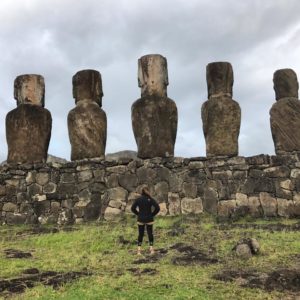
My travels in Rapa Nui were truly an eye-opening adventure. Easter Island holds many mysteries and one of the clues that we have to unlock the secrets are the volcanic stones that still exist on the island. The Tuff Rock, Red Scoria and Basalt are small hints that help us understand the native Rapa Nui people and their fascinating history.


